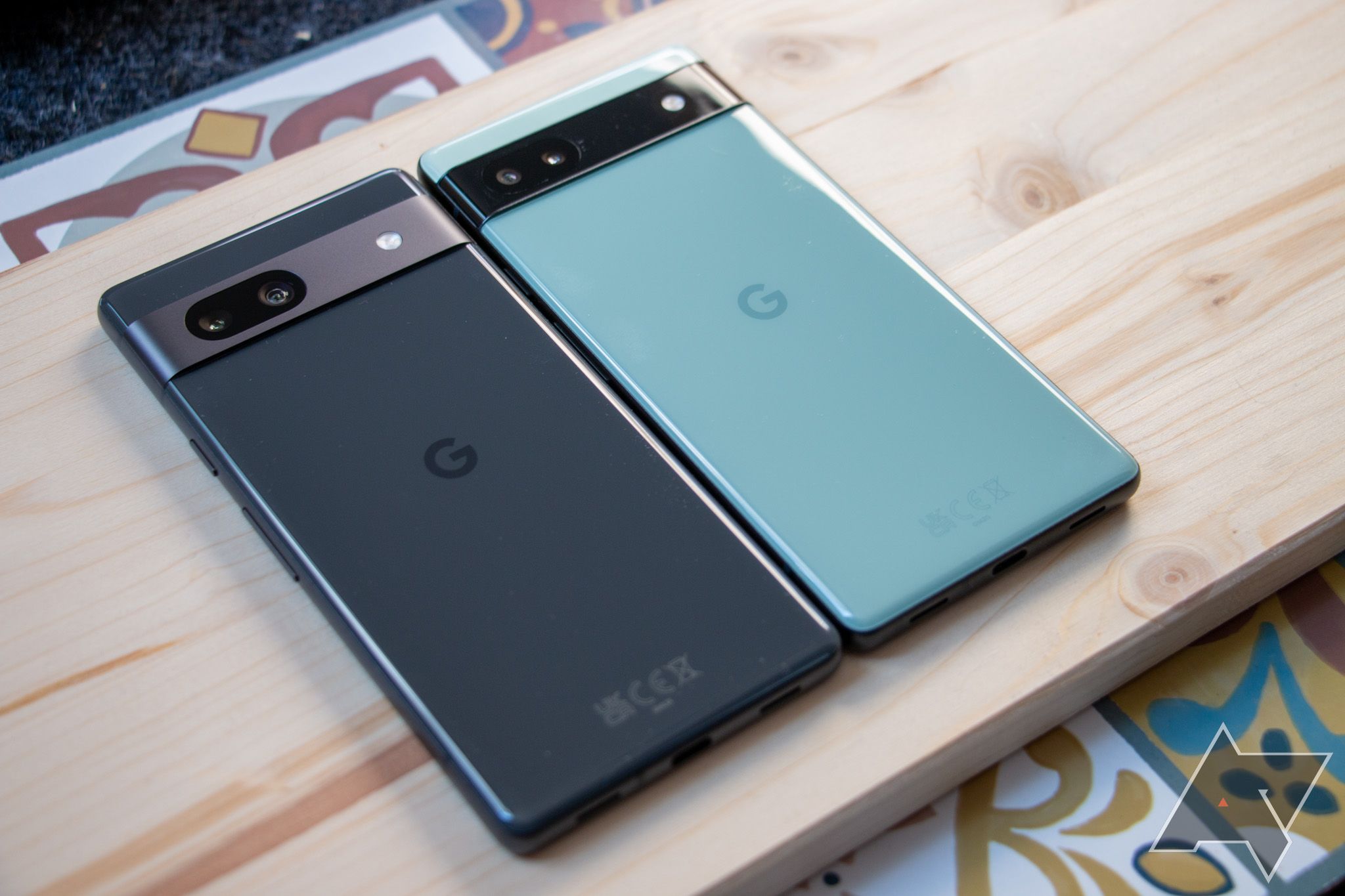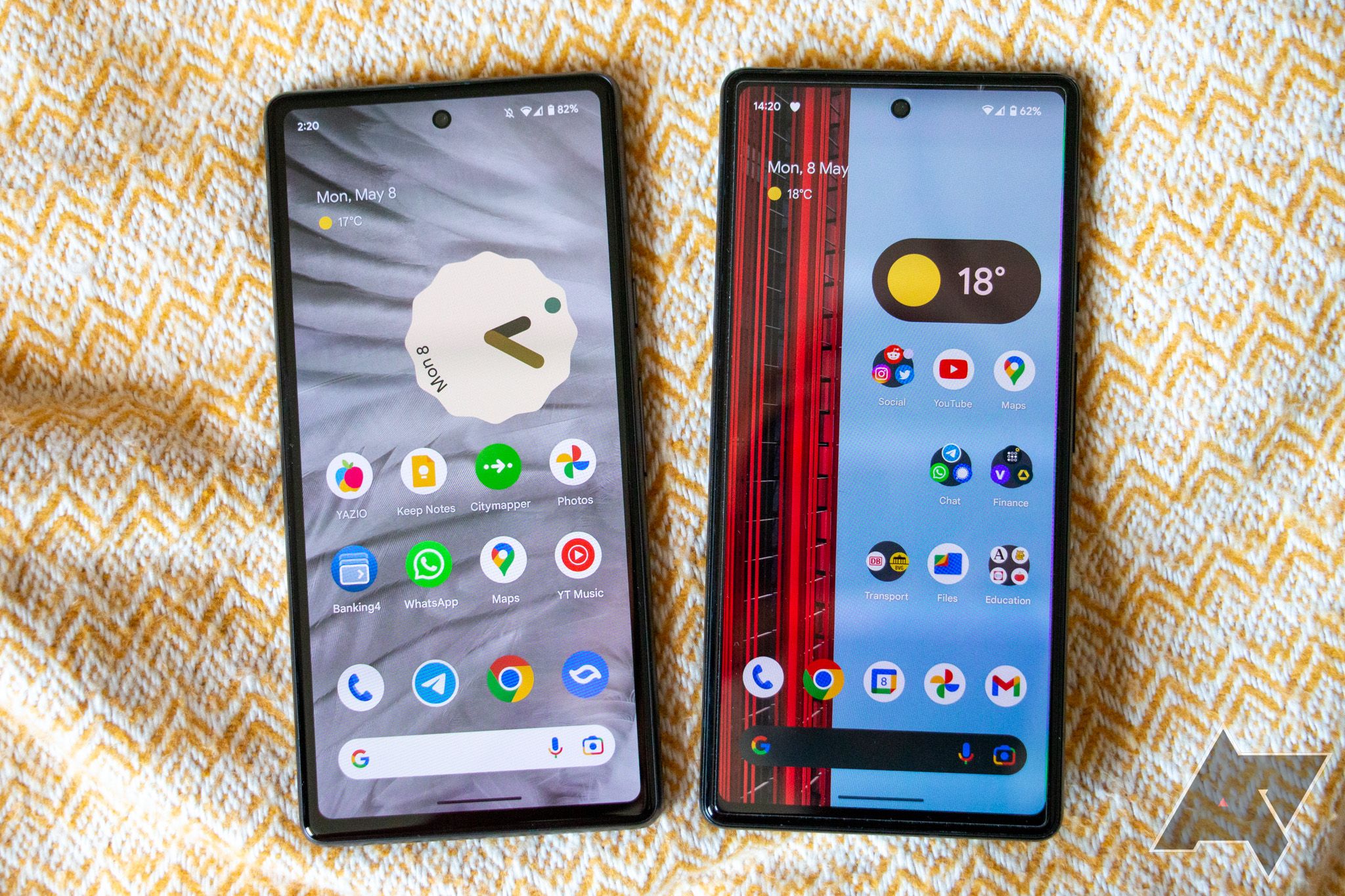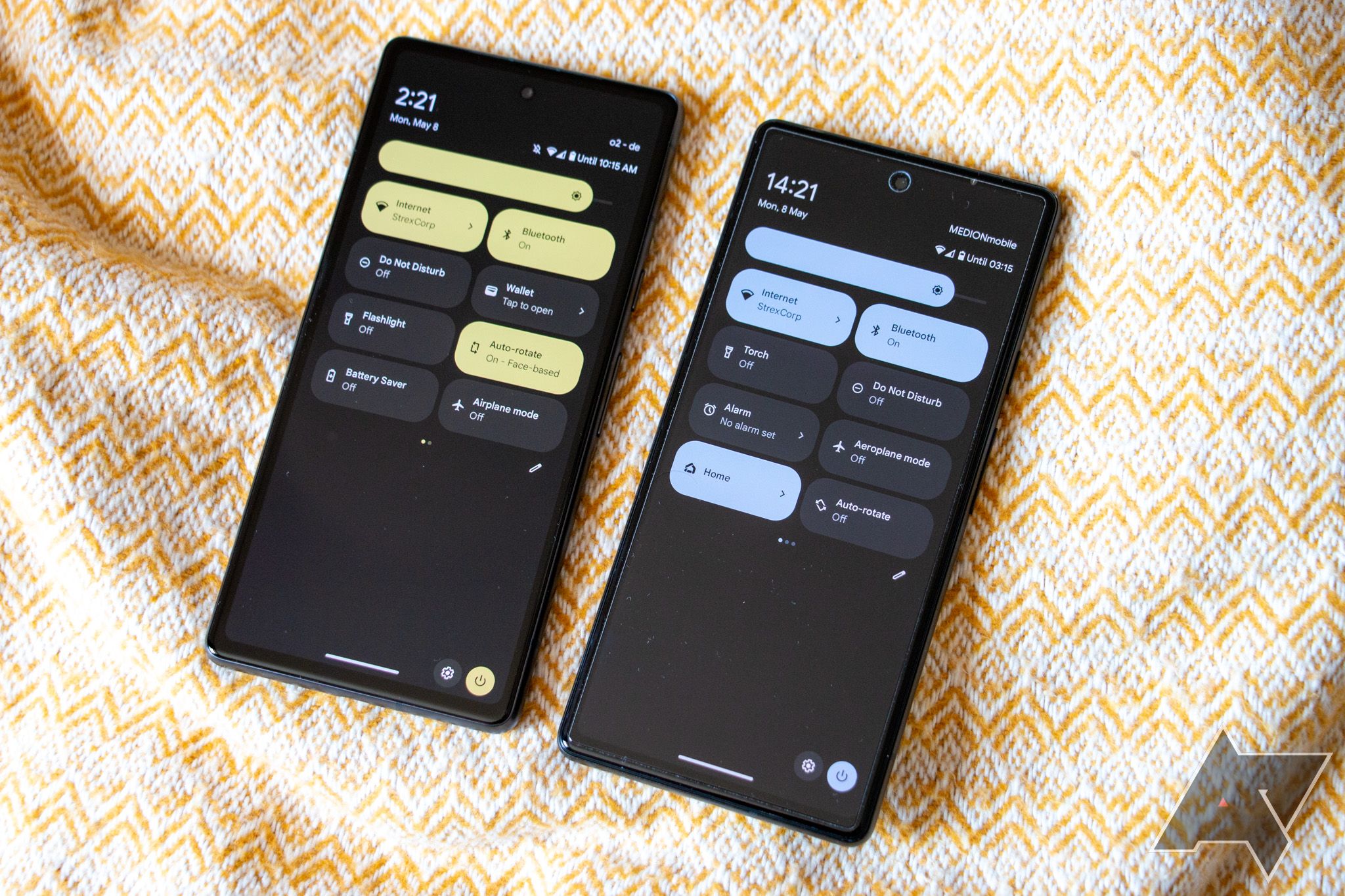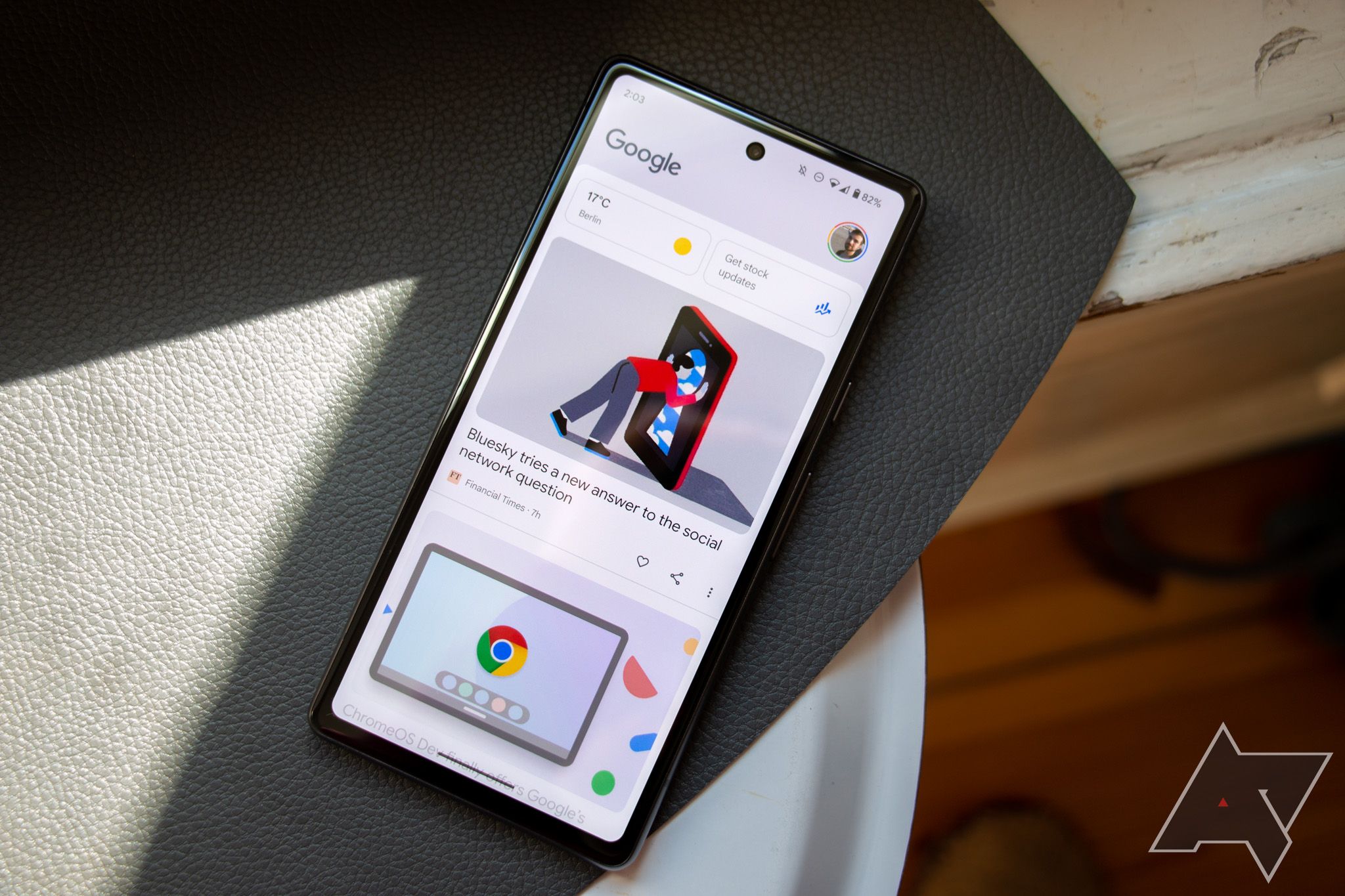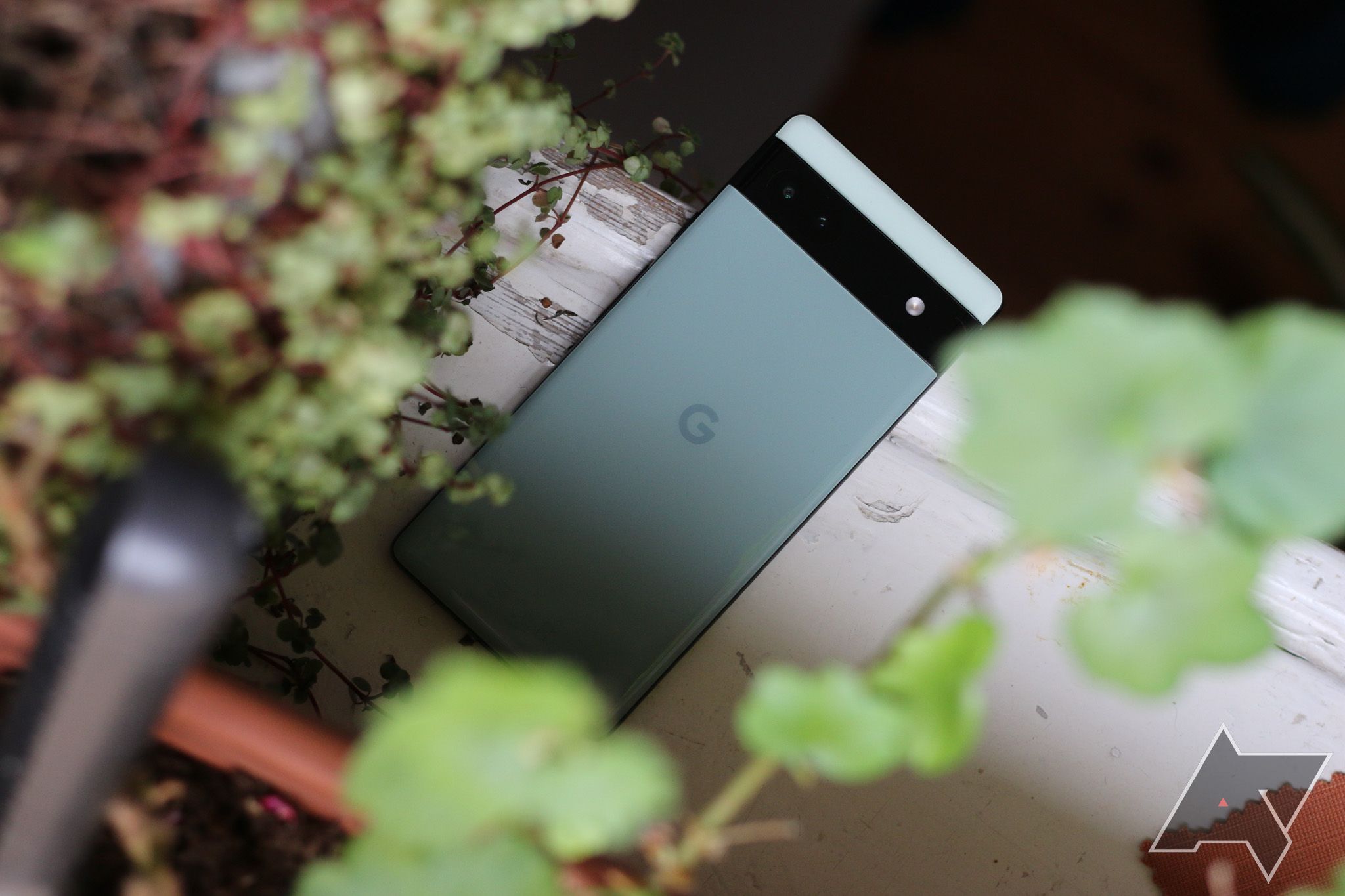-
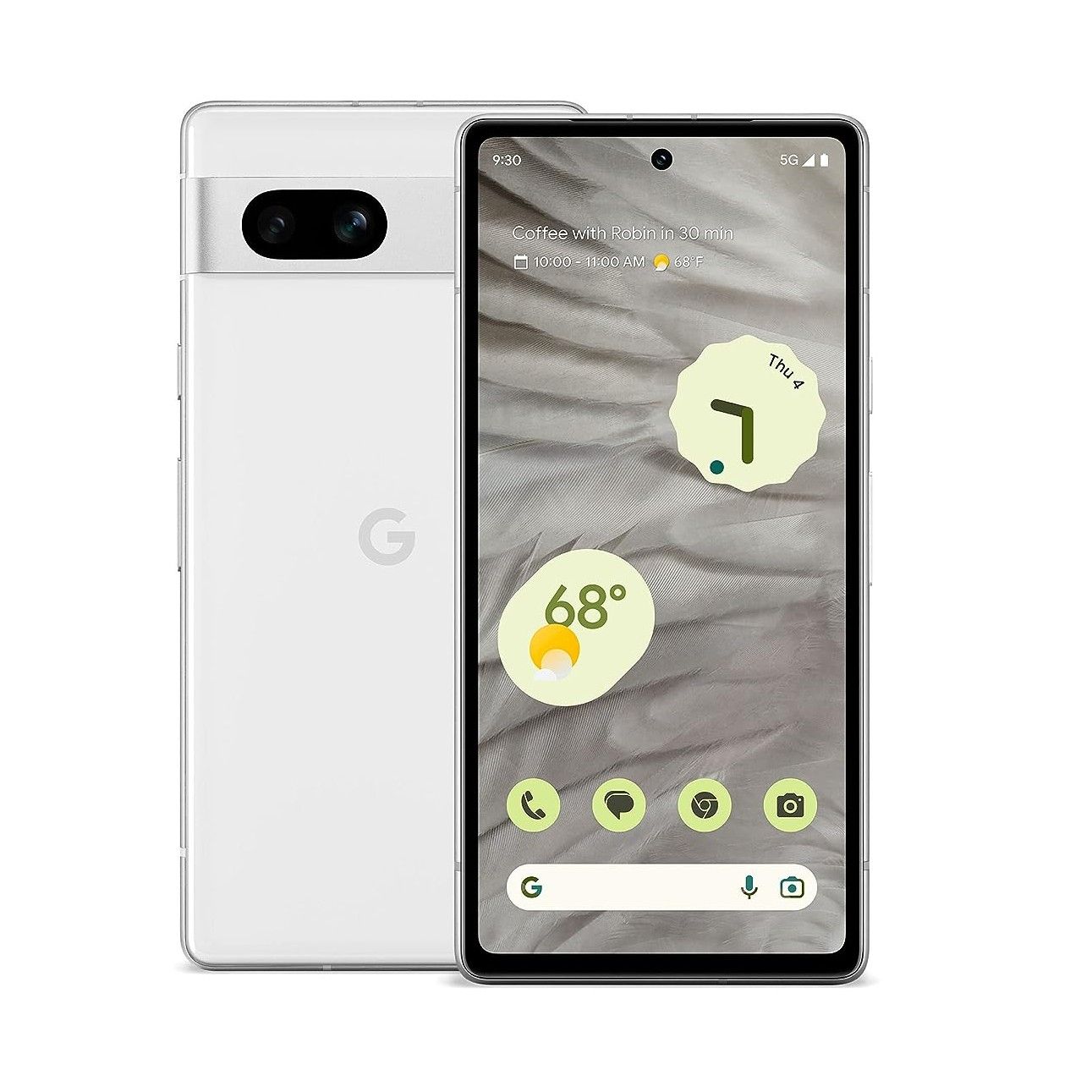
Google Pixel 7a
Outstanding phone, increased priceThe Pixel 7a offers features we've never seen on an A-series Pixel before: 90Hz screen, wireless charging, and an all-new camera setup. The upgrades come at a price, though.
Pros- 90Hz refresh rate screen
- Wireless charging
- Significantly better camera setup
Cons- More expensive
-
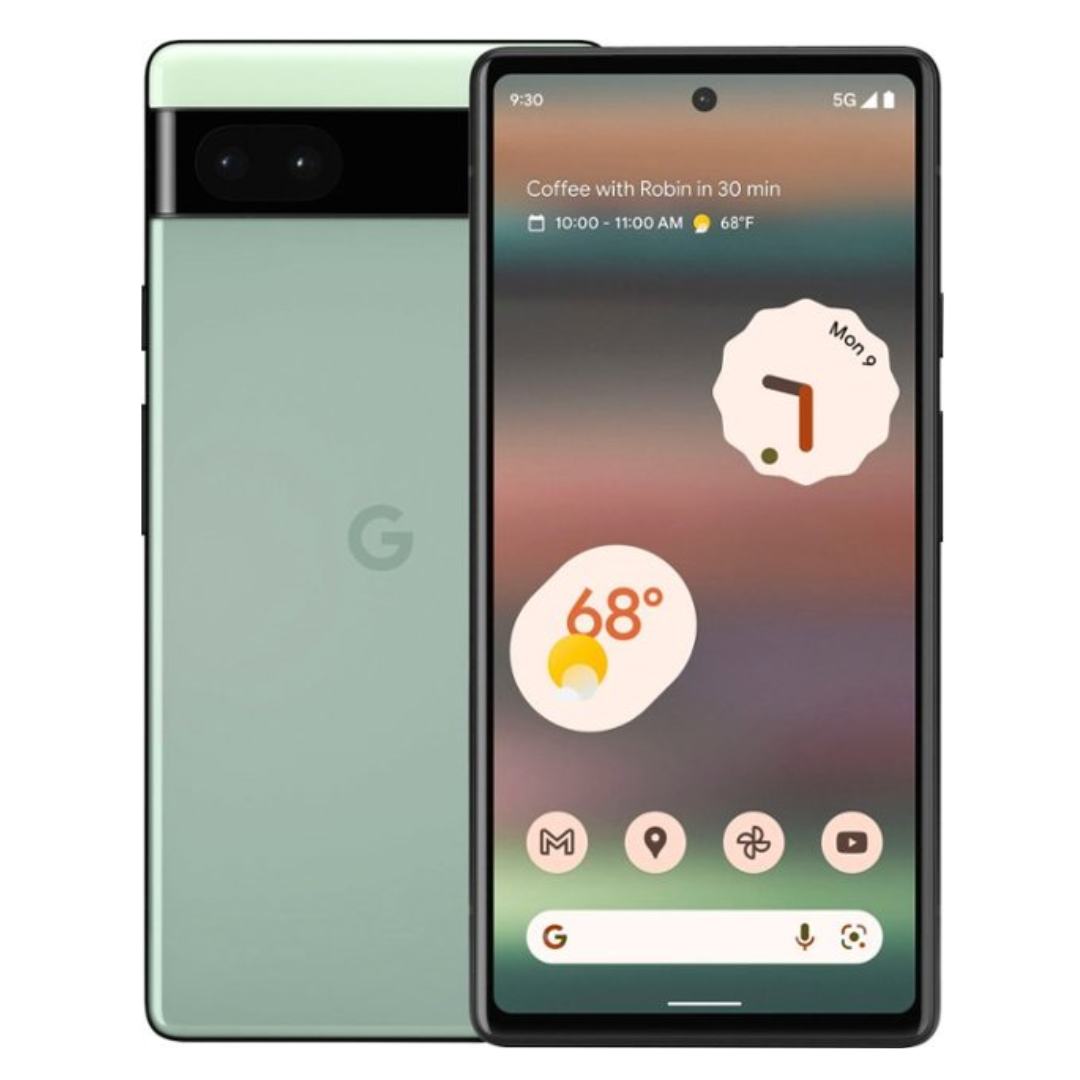
Google Pixel 6a
Unbeatable valueThe Pixel 6a has long been our favorite budget phone, and that remains true even with a new competitor on the market. The 6a is still a great phone, but it's only due one more Android version update.
Pros- Incredible bang for your buck
- Security updates until at least July 2027
Cons- No wireless charging
- Display limited to 60 hertz
- Only 1 full Android update left
The Google Pixel 6a was an instant hit at launch due to its excellent value and cutting-edge features. A year later, the Google Pixel 7a entered the conversation, and filled the 6a's big shoes surprisingly well. The 7a makes significant upgrades over its predecessor in many ways, finally offering some long-omitted features missing in Google's budget-friendly class.
With wireless charging, a 90Hz display, and improved processing power, the all-around great Pixel 7a stands as one of today's best affordable phones. If you already own a 6a, you will notice some big differences by moving up a generation, and you'll also get an additional year of Android and security updates. But the Pixel 6a still has Android 15 in its future, plus security patches through July 2027, and is a solid budget-friendly smartphone — especially when you can find it on sale.
Price, availability, and specs
The Google Pixel 7a launched on May 10, 2023, priced at $500. That's a $50 increase compared to the $450 price point that the Pixel 6a launched at in mid-2022. It's also incredibly close to the $600 Google Pixel 7, which the 7a actually outshined in some people's eyes.
If you take the Pixel 7 out of the picture for a minute and instead consider the $700 Google Pixel 8, we love the evenly spaced-out market segmentation here.
If you need something cheap, basic, and reasonably capable that'll last a few years, the 6a still deserves a look. $150 more nets you the impressively specced, but still not-quite-flasgship 7a with an extra Android version lined up. Then, another $200 premium brings you very near the top of the line with the Pixel 8. It's actually a little refreshing for a manufacturer to offer so few devices that all work so well, while being clearly aimed at different budgets.
-
Google Pixel 7a Google Pixel 6a SoC Google Tensor G2 Google Tensor RAM 8GB LPDDR5 6GB Storage 128GB 128GB Battery 4,385mAh 4,410mAh Ports USB-C USB-C Front camera 13MP, f/2.2 8MP, f/2.0 Connectivity NFC NFC Dimensions 152.4 x 72.9 x 9mm 152.2 x 71.8 x 8.9mm Weight 193g 178g IP Rating IP67 IP67 Rear camera 64MP, f/1.9 main with OIS; 13MP, f/2.2 ultrawide 12MP, f/1.73 main with OIS; 12MP, f/2.2 ultrawide Colors Charcoal, Snow, Sea, Coral Sage, Chalk, Charcoal Display type OLED, 90Hz OLED, 60Hz Charge speed 18W wired, 7.5W wireless 18W wired Display dimensions 6.1" 6.1” Charge options Wired, Wireless Wired Wi-Fi connectivity WiFi 6E Wi-Fi 6E Bluetooth Bluetooth 5.3 Bluetooth 5.2
Design: Leaning into the Google aesthetic
It's easy to tell the Pixel 7a and the Pixel 6a apart, even though they share many similarities in Google phone design language. The Pixel 6a follows closely with the rest of the Pixel 6 series, shipping to consumers with a two-tone back and sporting a darker shade at the top of the camera array and a pastel hue below. The camera array is also fully black and doesn't blend into the aluminum frame as well as the Pixel 7a's photography tools do.
The 7a, like the 7 and 7 Pro, is built with a single-color backplate with uniform shading above and below the camera array. In contrast to the Pixel 6a default black sides, its frame matches the rest of the phone.
The Pixel 7a's body is also slightly bigger than the previous generation. It's also slightly heavier than the previous model, weighing in at 193g, compared to the 6a's 178g. These specifics are minuscule differences, to be sure, and will only be noticed by the most eagle-eyed user. For all intents and purposes, the two devices are virtually carbon copies of one another in relation to size and weight.
Overall, the Pixel 7a is still lighter than many flagship phones, which are usually bigger and made out of more premium materials like glass or ceramics. This leads to another similarity, however — the Pixel 7a and its predecessor are both built with a plastic backing face. Personally, I'm a fan since the plastic construction translates into greater resistance to shattering when you drop it, which will inevitably happen at some point. Still, a great case is a must for the Pixel 7a to shore up any potential corner or screen vulnerabilities that continue to plague phones, both old and new.
If you ask me, the Pixel 7a looks and feels more refined than the Pixel 6a, something that I've also found to be true when comparing the standard Pixel 7 to its previous Pixel 6 model.
Display: Another affordable success
While it was possible to unlock 90Hz on some Pixel 6a units, Google never intended to ship 2022's top-budget phone with such a feature. With the Pixel 7a, this is a much different story. The 7a supports 90Hz refresh rates, which you'll have to manually enable in Settings after unboxing your new phone.
Other than this major change, the screens on the two phones are similar. The Pixel 6a comes with a 1080 x 2400 6.1-inch OLED, and 7a can get brighter, but sports a nearly identical pixel density. While the 7a is nowhere near the brightest phone out there, it's easily usable even in direct sunlight.
Both phones have significant bezels on all sides, with an even bigger one at the bottom, especially when you compare them to the Pixel 7 or Google Pixel 7 Pro. Once you start using either the Pixel 6a or the Pixel 7a in everyday life, this isn't something you'll notice much, however.
Software: Continuing to improve
Both the Pixel 7a and the Pixel 6a currently run Android 14 with the increasingly refined Pixel skin slapped on, but you're in for one extra software upgrade on the 7a. The Pixel 6a shipped with Android 12 at launch, meaning it will get upgraded to Android 15 and receive security patches until 2027. The Pixel 7a shipped with Android 13 out of the box and will be updated through to Android 16. Google also promises five years of security patches for it, so you're covered on this front until 2028.
The Pixel 7a also offers a few new software tricks that haven't made it to the Pixel 6a yet. Most notably, it supports face unlock and the fingerprint scanner built into the display itself. These features make the phone easier to unlock. That said, in my testing, I found that the Pixel 7a's fingerprint scanner is significantly better than the Pixel 6a's, so you might not even need to rely on face unlock if you prefer not to use it.
In addition, the Pixel 7a shares a few quality-of-life features that Google introduced to the Pixel 7 and Pixel 7 Pro. In the image editing department, you can use Photo Unblur to save shots that might otherwise be too blurry to use. When you charge your phone overnight next to your bed, you can also activate the Pixel 7a's cough and snore detection, which might help you spot health problems and sleeping issues that might otherwise remain undetected.
Other than that, both the Pixel 7a and Pixel 6a offer Google's usual suite of productivity, management, and optimization features, like the At a Glance widget on the home and lock screens that proactively offers updates about calendar events and more, automatic song recognition in the background, transcriptions and speaker labels in Google Recorder, and so much more.
The big advantage of both phones is that they come with little to no bloatware or duplicate apps. Google's role as manufacturer means that only its own software and app packages appear as native installations out of the box. There are no outside influences or contributors that tack on their own applications. Unfortunately, this isn't something that can be said when it comes to other Android device makers.
Performance: Newer is, predictably, better
The Google Pixel 7a comes with Google's custom Tensor G2 chipset, and the 6a the first-generation Tensor. In everyday life testing, I don't notice much difference between the two. But, on heavier workloads, like navigating in Google Maps or taking tons of photos and videos, you will notice that the Pixel 7a has an edge.
The same is true when it comes to multitasking. The Pixel 7a has 8GB of RAM, while the Pixel 6a only has 6GB. That may not be a problem now, but it could hinder performance as apps continue to get more complex. The 6a also gets hotter under load than the Pixel 7a, but really, both phones are among the toastier compared to the competition.
While it has never been an issue for me, many people also report tons of connectivity problems with the first-generation Tensor chip used across the whole Pixel 6 lineup. This problem is much less pronounced with the Tensor G2 that has been implemented in the Pixel 7a, but if you live in an area with chronically bad mobile connectivity, you might be better off with a phone that has a Snapdragon processor.
Right now, the Pixel 6a does a good job with any moderate workload, but if you're in for the long haul and would like to keep your phone for years to come, the 7a definitely boasts added performance and connectivity overhead. It's a slight edge at present, but the rift between the two devices will continue to widen with time.
Battery life: Still pretty OK
The Pixel 7a has a slightly smaller battery than the Pixel 6a, with 4,385mAh pitted against the 6a's 4,410mAh. In everyday life, this shouldn't equate to much of a difference, though. The Pixel 7a's screen may have a higher refresh rate, but its processor is also more efficient, so you shouldn't notice any real discrepancy between the two.
Like all Pixel phones, the Pixel 6a and 7a aren't battery champions. Normal usage without gaming and with a good connection should make it through a full day from morning to bedtime. Yet, there isn't much overhead in this battery timeline. Both the Pixel 7a and the 6a only support 18W of fast charging, which isn't really fast anymore in a world where other phones routinely charge up at loads of 50W or higher.
However, a big advantage of the Pixel 7a is that it finally supports wireless charging. If you love the convenience of just placing your phone down on a charging pad without worrying about plugging in a cable, you'll love that this feature is now finally available in the Pixel A-series, only four generations after the standard lineup brought it into the fold.
Cameras: When good gets better
Pixel phones have always been known for their great cameras, and the Pixel 6a still takes good photos. You will notice that its hardware is getting older, though, especially when compared to newer flagship models out there. The Pixel 6a only has a 12.2MP primary camera — the same specs available in the Pixel 3 and Pixel 3a — and offers a paired 12MP ultrawide function. The Pixel 7a represents a gigantic leap in this department, offering a 64MP primary and a much improved ultrawide with 13MP and a 120° FoV. In numbers, this even surpasses the photography performance of the Pixel 7.
In practice, you'll notice a difference right away. Both the 6a and the 7a offer the signature Pixel photo look, but with the Pixel 7a, you can crop photos much tighter before you lose quality, detail, and sharpness. This becomes even clearer when you use the zoom function. While the Pixel 6a is capped at a maximum of 7x, the Pixel 7a can go up to 8x and even surpasses the Pixel 7 in sharpness at this level.
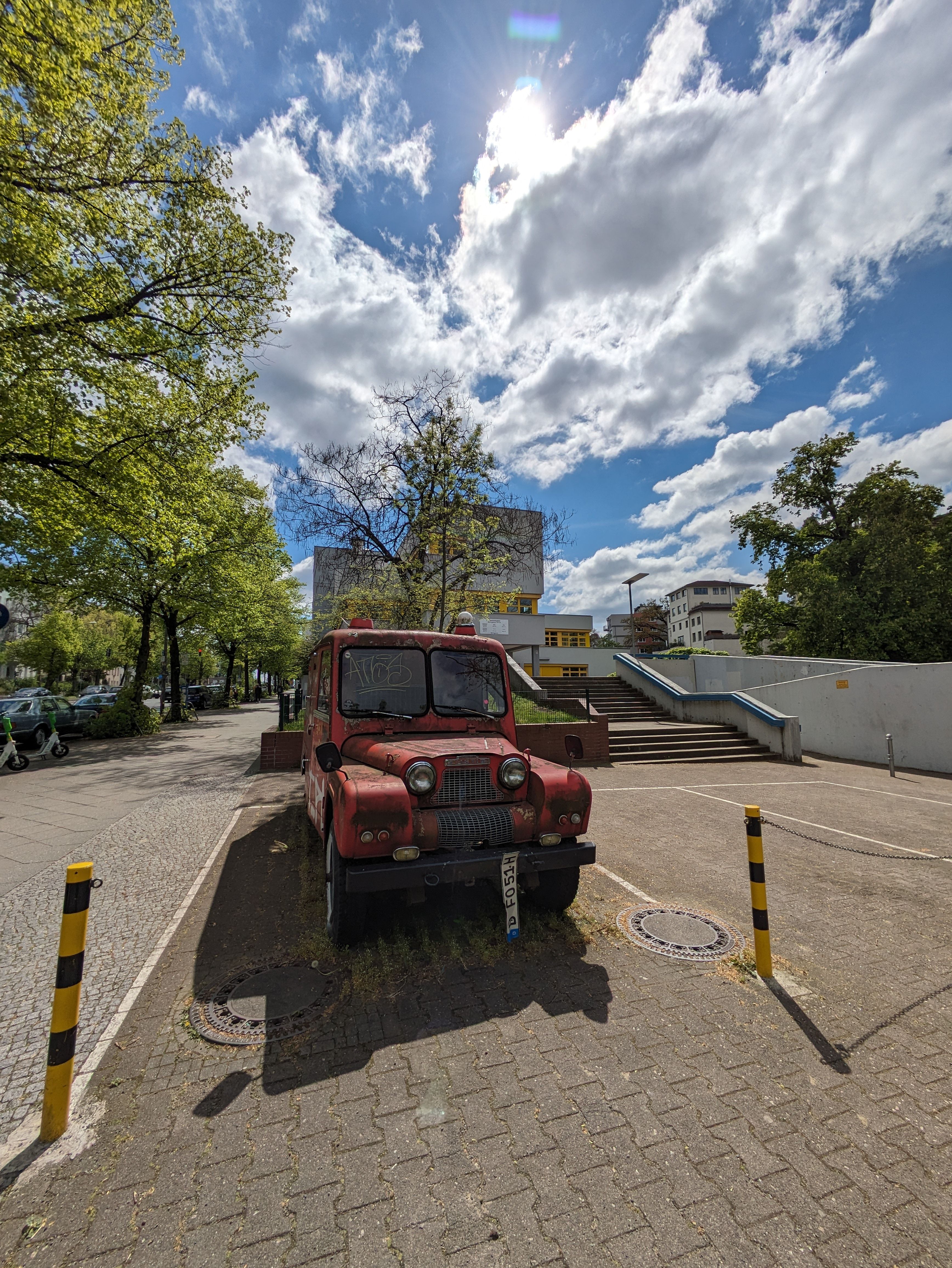
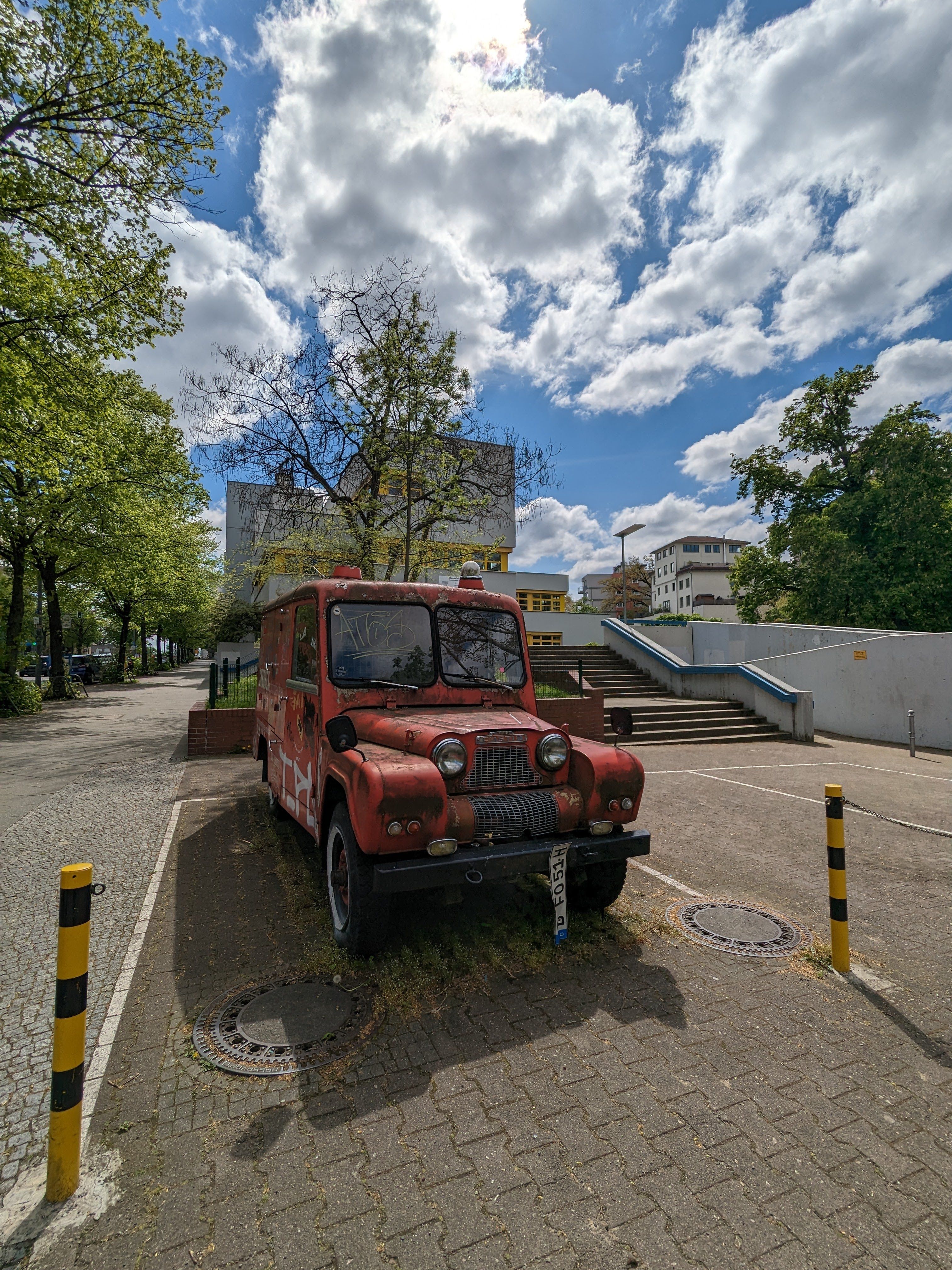
Pixel 7a's new ultrawide camera vs. Pixel 6a's
The new ultrawide camera is also a wonderful addition, allowing a much wider field of view. On paper, the difference between 114° and 120° may seem small, but you get a lot more room to play with in the viewfinder and when viewing or editing the resulting photos.




Pixel 7a vs. Pixel 6a: Regular zoom level on waterfall and highest zoom level on tower
The Pixel 7a is also leaps and bounds better at night photography, though you'll have to check out our full review for more details and samples. Essentially, the Pixel 7a is twice as fast at capturing and computing images in dark environments, right on par with the camera improvements that Google introduced to the Pixel 7 and 7 Pro when they first launched.
Which is right for you?
The Pixel 7a is the biggest upgrade in the Pixel A-series since its inception, and it finally brings some long-awaited features to Google's budget phones. Wireless charging has become a key convenience that takes the hassle out of charging, and being able to unlock your phone with your face is also a quality-of-life improvement that many users will welcome with open arms.
The 90Hz screen refresh rate acts as the icing on top of it all, making doom-scrolling sessions feel almost pleasant. All these upgrades come at a cost, and at $500, the Pixel 7a is the most expensive Pixel A-series phone ever. Nonetheless, with two more Android versions and four years of security patches yet to come, it remains one of our favorite midrange smartphones.

Google Pixel 7a
Outstanding phone at a moderate cost
The PIxel 7a is a budget phone on the outside with its plastic back, but a flagship at heart with a versatile camera setup and a good screen. The price is still pretty high, though.
If you insist on having the most cutting-edge features, high-powered hardware, and advanced software tricks, walk right past the Pixel 6a. But if you really just want the dependable quality control, convenient Android implementation, and user-friendly camera that Google's been known for over the last few years, the 6a might actually make sense.
After all, it's a known quantity at this point, with few enough downsides that Google continues to sell it alongside the newer 7a. You know exactly what you're getting for $340, and that is a reliable, no-nonsense, reasonably powerful phone that can tackle the vast majority of modern apps and isn't bad at chugging through an entire day without being recharged. It's not nearly on the level of Google's latest flagships, but it was never meant to be. And it's an especially enticing choice if you can manage to find it at a discount.

Google Pixel 6a
Perfect for the price
Even though it's no longer the newest A-series phone in town, the Pixel 6a has a lot going for it thanks to its incredible bang-for-the-buck ratio, the Pixel software experience, and the unique design.

